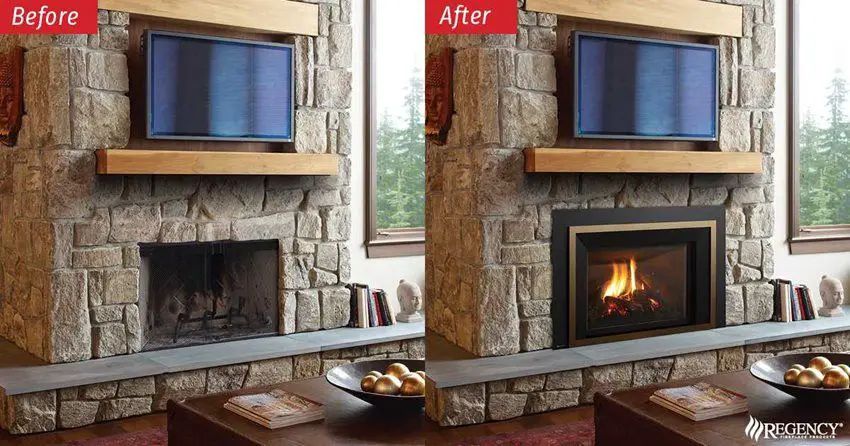Your fireplace is gas if it has ceramic logs, gas connections, an ignitor, and a control knob. For electric fireplaces, look for easy setup, energy efficiency, and safety features.
Determine your fireplace type by checking the firebox and chimney materials. Gas fireplaces do not rely on electricity but may have electric ignitions. If you see a vent on the side of your house, it’s likely a gas fireplace. Understanding your fireplace type helps with maintenance and operation in the long run.
Identifying Your Fireplace Type
Do you know if your fireplace is gas or electric? A simple way to identify your fireplace type is by checking the firebox and chimney. If the firebox is made of brick, tile, or blocks with a traditional chimney, it’s likely to be a wood-burning fireplace.

If it has ceramic logs, gas connections, ignitor, and control knob, then it’s a gas fireplace. For electric fireplaces, look for safety, ease of installation, energy efficiency, and lower running costs.
Check The Firebox And Chimney
Inspect the interior of your fireplace to determine the materials used in the firebox and look for a traditional chimney connection.
Look For Valves And Connections
Examine for valves, gas connections, ignitors, control knobs, or remote controls to identify a gas fireplace.

Credit: www.regency-fire.com
Differences Between Gas And Electric Fireplaces
Gas fireplaces are known for their genuine burning flame and higher heat output, while electric fireplaces offer safety and easy maintenance. Differentiating between the two is key – gas units operate independently of electricity, with venting options, while electric fireplaces rely on a power source for functionality.
Safety And Installation
When it comes to safety, gas fireplaces require proper ventilation to prevent the buildup of carbon monoxide. Electric fireplaces, on the other hand, are safer as they do not emit any harmful gases. Installation of a gas fireplace involves setting up gas lines and regular maintenance checks for leaks.
On the contrary, electric fireplaces are easy to install – simply plug them into a standard outlet. They do not require professional installation or special ventilation, making them a safer and more convenient option for homeowners.
Running Costs And Heat Output
Gas fireplaces generally have lower running costs due to the price of natural gas. They provide a higher heat output, making them ideal for heating larger spaces efficiently. However, gas fireplaces require a source of fuel, which might not be suitable for all budgets.
Electric fireplaces have lower running costs since they operate on electricity. While they may not produce as much heat as gas fireplaces, they are more energy-efficient and provide consistent warmth without the need for refueling.
Operating Your Fireplace
When it comes to operating your fireplace, understanding its electricity usage and functionality during power outages is crucial for a seamless user experience. Whether you have a gas or electric fireplace, knowing these details will help you make the most of your heating appliance.
Electricity Usage
An electric fireplace typically consumes between 1,400 and 1,600 watts during operation. To put this into perspective, the standard rate of electricity in the United States is around 12 cents per kilowatt-hour, so using an electric fireplace for an hour can cost approximately 17 to 19 cents.
Functionality During Power Outages
Gas fireplaces are touted for their reliability during power outages. Since they are fueled by natural gas, they do not rely on electricity to function. Many gas fireplaces feature manual ignition, allowing them to be operated even when there’s a power loss in the area. This provides peace of mind during inclement weather or other situations that result in power interruptions.

Credit: www.homedepot.com
Venting Systems
Venting systems play a crucial role in determining whether your fireplace is gas or electric. A visual inspection of the chimney and interior materials can help identify the type of fireplace in your home. Gas fireplaces typically have identifiable features such as ceramic logs and gas connections, while electric fireplaces are known for their safety and energy efficiency.
Direct Venting For Gas Fireplaces
When it comes to gas fireplaces, direct venting is the most common venting system used. This type of venting allows the fireplace to draw air from outside the home for combustion and expels the combustion gases through a dedicated vent pipe. Direct venting is a sealed system, which means it provides a continuous oxygen supply for the gas fireplace and eliminates the need for a traditional chimney. With a direct vent gas fireplace, you have the flexibility to install the unit on any wall in your home as long as it can be vented to the outdoors. This makes it a versatile option for homeowners who want to add a fireplace to their living space. Additionally, direct venting provides excellent energy efficiency by preventing the loss of heated air from your home.Chimney Usage For Wood-burning Fireplaces
Wood-burning fireplaces rely on a traditional chimney system for venting. When you burn wood in your fireplace, the smoke, ash, and other combustion byproducts are expelled through the chimney and out of your home. The chimney serves as a conduit to safely remove these gases while also providing a draft for the fire to burn efficiently. It’s important to note that if you have a prefabricated wood-burning fireplace, it typically has a metal interior rather than a traditional brick or stone firebox. This metal interior is designed to withstand high temperatures and ensure the safe operation of the fireplace. If you’re unsure whether your fireplace is gas or electric, a simple way to determine its type is by looking inside and up the chimney. If the firebox is made of brick, tile, or blocks and connected to a traditional chimney, then you likely have a wood-burning fireplace. On the other hand, if your fireplace has ceramic logs in the firebox and is not connected to a chimney, it is most likely a gas fireplace. In conclusion, understanding the venting system of your fireplace is crucial, as it determines the type of fuel it uses and the installation options available. Whether you have a gas fireplace with direct venting or a wood-burning fireplace that relies on a chimney, knowing the specifics of your fireplace will help you make informed decisions regarding maintenance, usage, and safety.Comparison Of Gas And Electric Fireplaces
Gas fireplaces burn natural gas and don’t rely on electricity, while electric fireplaces are easy to install, energy-efficient, and low maintenance. Gas models offer a genuine burning flame, higher heat output, and lower running costs, making them a great choice if you prefer a traditional fireplace ambiance.
When it comes to choosing a fireplace for your home, you have two main options: gas or electric. Each type offers its own advantages and considerations. In this section, we will compare gas and electric fireplaces in terms of their pros and cons, as well as location considerations for electric fireplaces.
Pros And Cons Of Gas Fireplace Inserts
Gas fireplace inserts are a popular choice for homeowners who want the warmth and ambiance of a traditional fire without the hassle of wood. Here are some pros and cons to consider:
| Pros | Cons |
|---|---|
|
|
As you can see, gas fireplace inserts offer convenience and a realistic flame, but they do require a gas line and proper ventilation. They are a great option for homeowners looking for a permanent fireplace solution.
Location Considerations For Electric Fireplaces
Electric fireplaces, on the other hand, offer flexibility and ease of installation. Here are some location considerations to keep in mind:
- Portability: Electric fireplaces are typically portable and can be moved from room to room as needed.
- Power source: Electric fireplaces require access to a power outlet, so you’ll need to consider the location of electrical sockets in your home.
- No venting required: Unlike gas fireplaces, electric fireplaces do not require venting, allowing for greater placement options.
- Size and style: Electric fireplaces come in a variety of sizes and styles, so you can choose one that fits your space and decor.
- Heat output: Electric fireplaces may not provide the same level of heat as gas fireplaces, so consider your heating needs when choosing a location.
Electric fireplaces are a practical choice for homeowners who want the convenience of a fireplace without the need for extensive installation or a dedicated gas line. Their portability and versatility make them a great option for any room in your home.

Credit: www.homeadvisor.com
Frequently Asked Questions Of Is My Fireplace Gas Or Electric
How Do I Know What Kind Of Fireplace I Have?
To know what kind of fireplace you have, look inside and up the chimney. If the firebox is made of brick, tile, or blocks and connected to a traditional chimney, it’s a wood-burning fireplace. If there are ceramic logs, valves, a gas connection, and controls, it’s a gas fireplace.
Electric fireplaces are easy to install, energy efficient, and have no real flame. Gas fireplaces have lower running costs and higher heat output. Gas fireplaces don’t require electricity to function.
How Do I Know If My Fireplace Is Gas Only?
To determine if your fireplace is gas only, check for ceramic logs, valves, a gas connection, an ignitor, a control knob, and possibly a remote control. Also, look for a vent on the side of your house, as gas fireplaces typically use direct vent or natural venting systems instead of chimneys.
What Is The Difference Between A Gas Fireplace And An Electric Fireplace Heater?
The gas fireplace uses natural gas and provides authentic flame and more heat, while the electric fireplace heater is safer, easier to install, and energy-efficient. Gas fireplaces have lower running costs and higher heat output than electric ones.
Does My Gas Fireplace Use Electricity?
Yes, gas fireplaces are fueled by natural gas and do not require electricity to function. Some may have electric ignitions, but they can still be operated manually in case of a power outage.
How Do I Know If My Fireplace Is Gas Only?
If your fireplace has ceramic logs in the firebox, it burns gas! There should be valves, a gas connection, an ignitor, a control knob, and maybe even a remote control. It’s important to figure out quickly whether your gas fireplace is vented or vent-free.
Conclusion
Identifying whether your fireplace is gas or electric can be determined by examining the materials used, the presence of a gas connection, and an electric ignitor. By following simple cues, homeowners can determine the type of fireplace they have, allowing for better maintenance and operation.
Understanding the differences between gas and electric fireplaces will help in making informed decisions for your home.